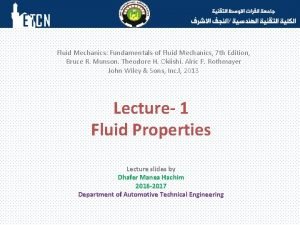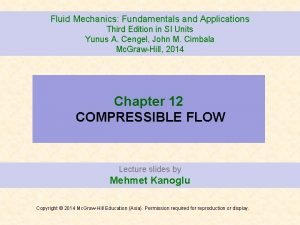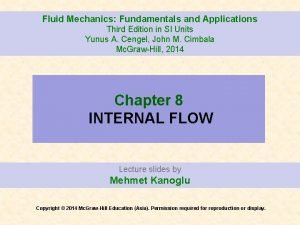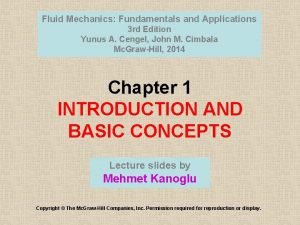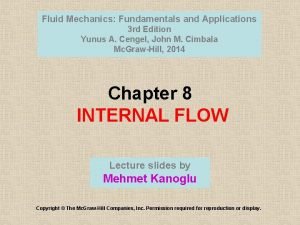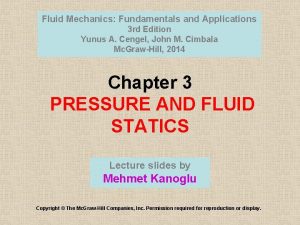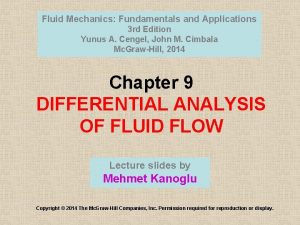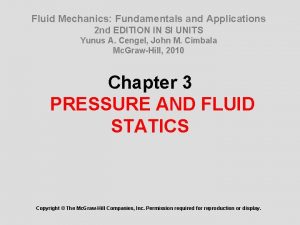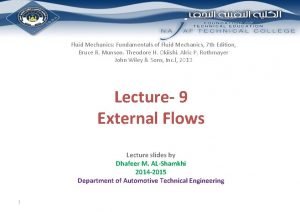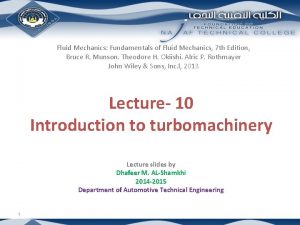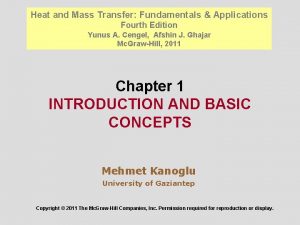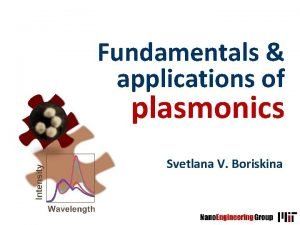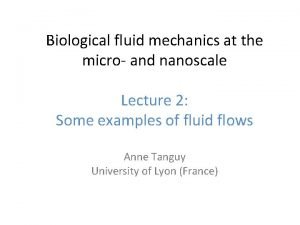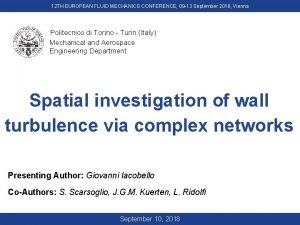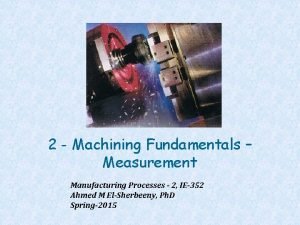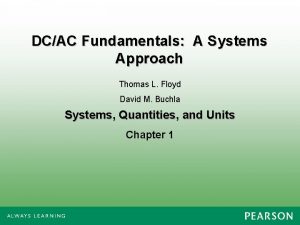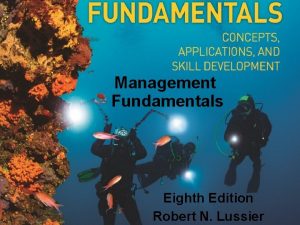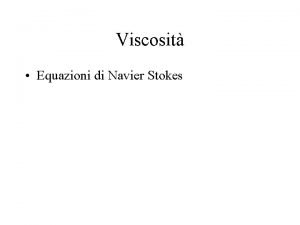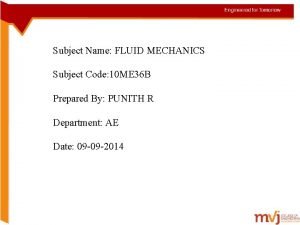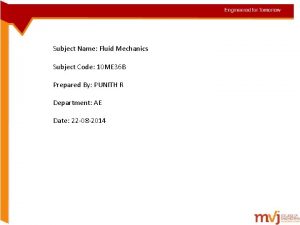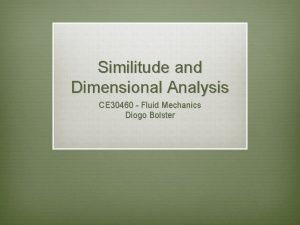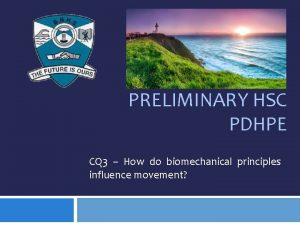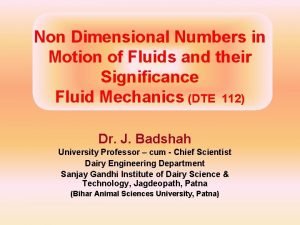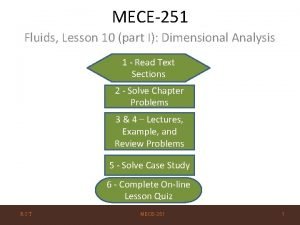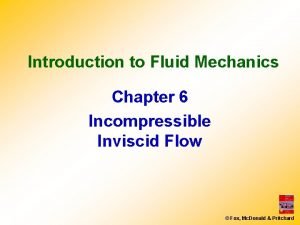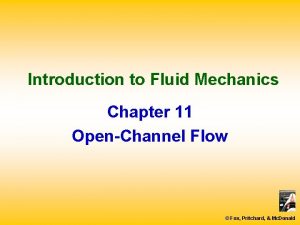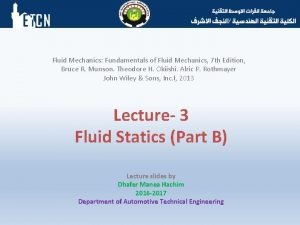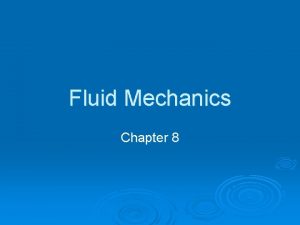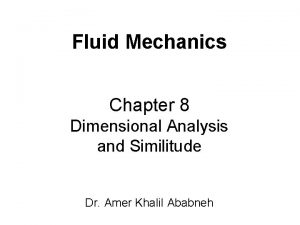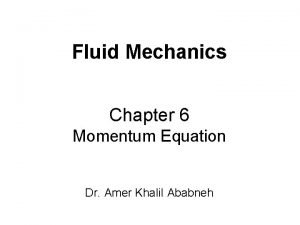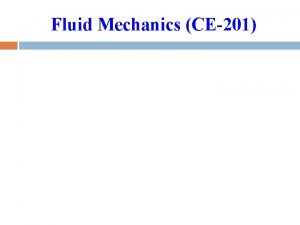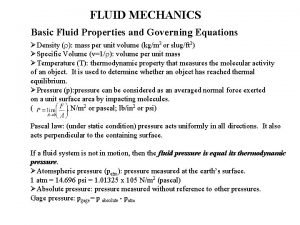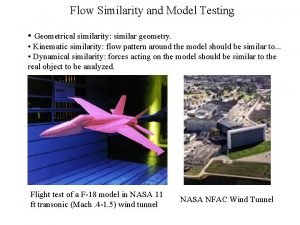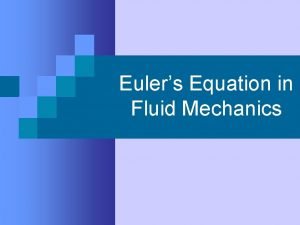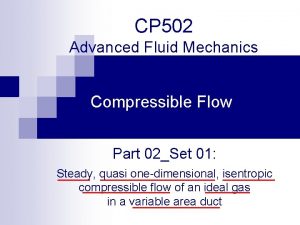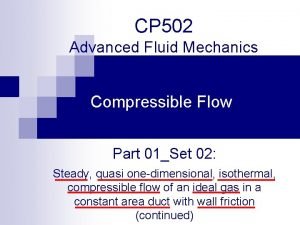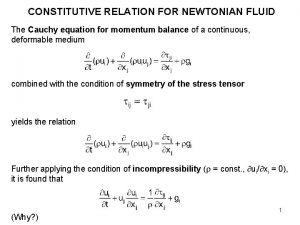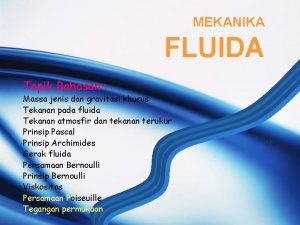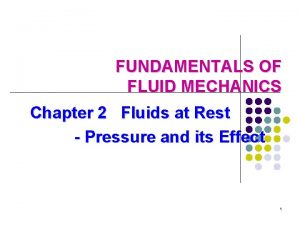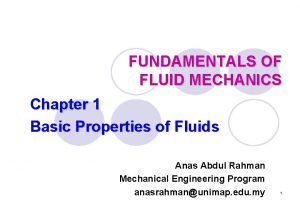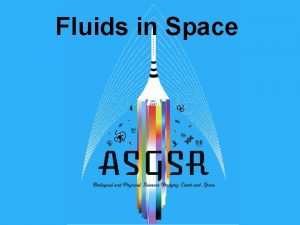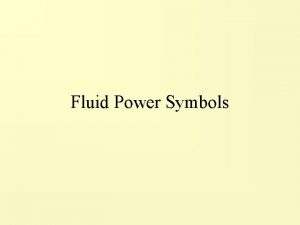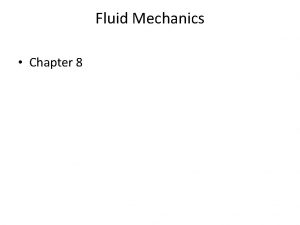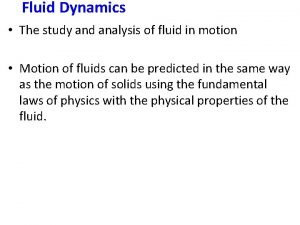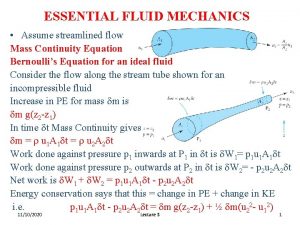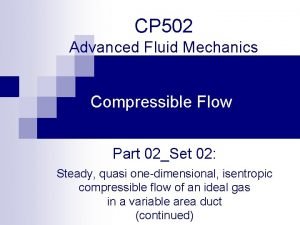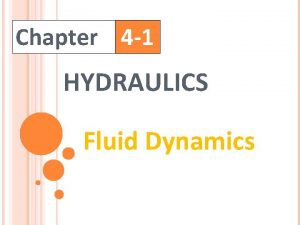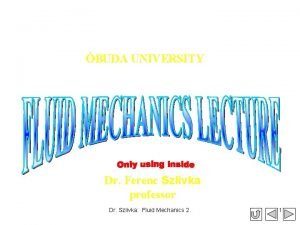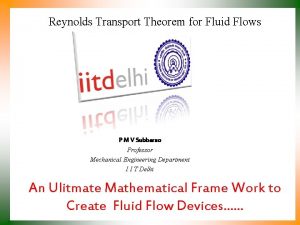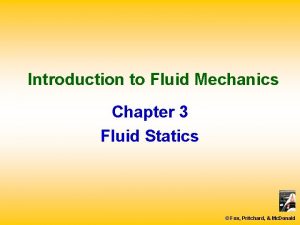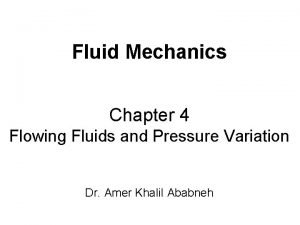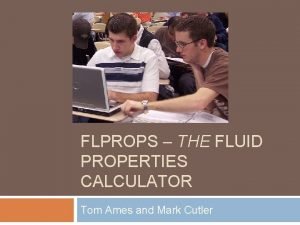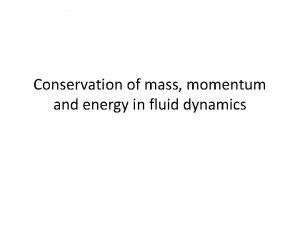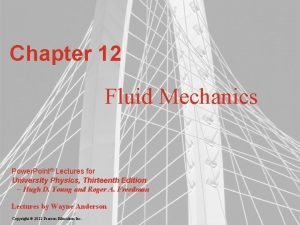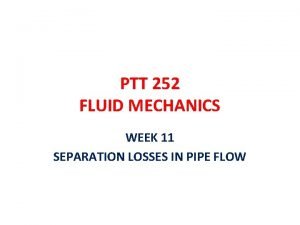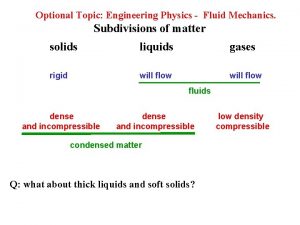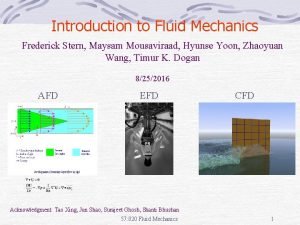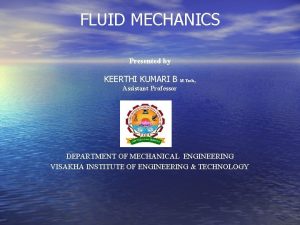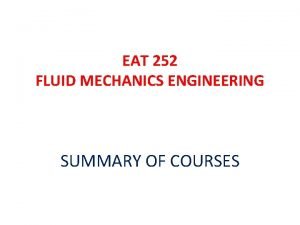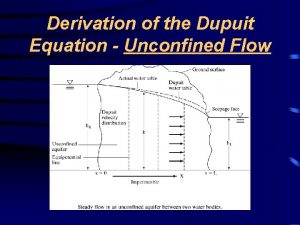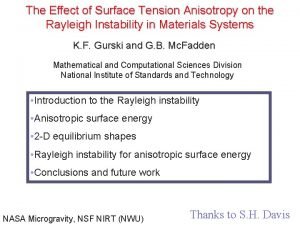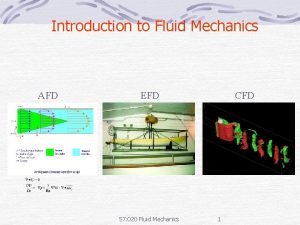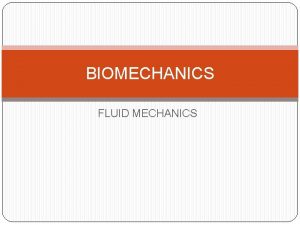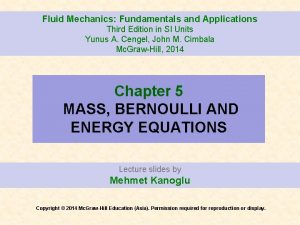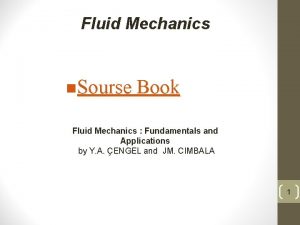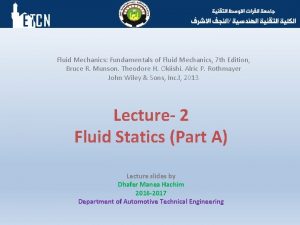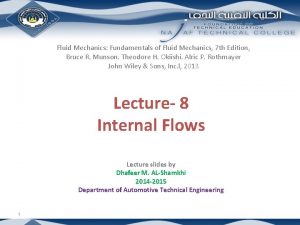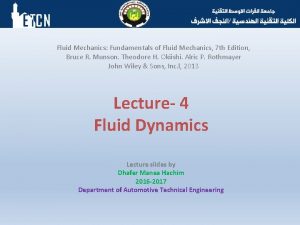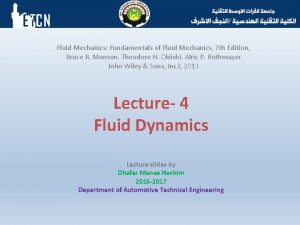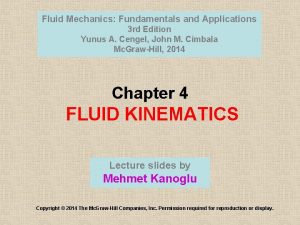Fluid Mechanics Fundamentals and Applications Third Edition in

































































































- Slides: 97

Fluid Mechanics: Fundamentals and Applications Third Edition in SI Units Yunus A. Cengel, John M. Cimbala Mc. Graw-Hill, 2014 Chapter 12 COMPRESSIBLE FLOW Lecture slides by Mehmet Kanoglu Copyright © 2014 Mc. Graw-Hill Education (Asia). Permission required for reproduction or display.

High-speed color schlieren image of the bursting of a toy balloon overfilled with compressed air. This 1 -microsecond exposure captures the shattered balloon skin and reveals the bubble of compressed air inside beginning to expand. The balloon burst also drives a weak spherical shock wave, visible here as a circle surrounding the balloon. The silhouette of the photographer's hand on the air valve can be seen at center right. 2

Objectives • Appreciate the consequences of compressibility in gas flow • Understand why a nozzle must have a diverging section to accelerate a gas to supersonic speeds • Predict the occurrence of shocks and calculate property changes across a shock wave • Understand the effects of friction and heat transfer on compressible flows 3

12– 1 ■ STAGNATION PROPERTIES Stagnation (or total) enthalpy Static enthalpy: the ordinary enthalpy h Energy balance (with no heat or work interaction, no change in potential energy) Steady flow of a fluid through an adiabatic duct. Aircraft and jet engines involve high speeds, and thus the kinetic energy term should always be considered when analyzing them. 4

If the fluid were brought to a complete stop, the energy balance becomes Stagnation enthalpy: The enthalpy of a fluid when it is brought to rest adiabatically. During a stagnation process, the kinetic energy of a fluid is converted to enthalpy, which results in an increase in the fluid temperature and pressure. The properties of a fluid at the stagnation state are called stagnation properties (stagnation temperature, stagnation pressure, stagnation density, etc. ). The stagnation state is indicated by the subscript 0. Kinetic energy is converted to enthalpy during a stagnation process. 5

Isentropic stagnation state: When the stagnation process is reversible as well as adiabatic (i. e. , isentropic). The stagnation processes are often approximated to be isentropic, and the isentropic stagnation properties are simply referred to as stagnation properties. When the fluid is approximated as an ideal gas with constant specific heats Stagnation (or total) temperature T 0 : It represents the temperature an ideal gas attains when it is brought to rest adiabatically. Dynamic temperature: V 2/2 cp : corresponds to the temperature rise during such a process. The actual state, actual stagnation state, and isentropic stagnation state of a fluid on an h-s diagram. 6

Stagnation pressure P 0 : The pressure a fluid attains when brought to rest isentropically. Stagnation density 0 When stagnation enthalpies are used, the energy balance for a single-stream, steady-flow device When the fluid is approximated as an ideal gas with constant specific heats The temperature of an ideal gas flowing at a velocity V rises by V 2/2 cp when it is brought to a complete stop. 7

8

9

12– 2 ■ ONE-DIMENSIONAL ISENTROPIC FLOW speed of sound For an ideal gas k the specific heat ratio of the gas R the specific gas constant Mach number During fluid flow through many devices such as nozzles, diffusers, and turbine blade passages, flow quantities vary primarily in the flow direction only, and the flow can be approximated as onedimensional isentropic flow with good accuracy. 10

11

12

13

Note that as the pressure decreases, the temperature and speed of sound decrease while the fluid velocity and Mach number increase in the flow direction. The density decreases slowly at first and rapidly later as the fluid velocity increases. 14

Variation of normalized fluid properties and cross-sectional area along a duct as the pressure drops from 1400 to 200 k. Pa. 15

We note from Example that the flow area decreases with decreasing pressure up to a critical-pressure value (Ma = 1), and then it begins to increase with further reductions in pressure. The Mach number is unity at the location of smallest flow area, called the throat. The velocity of the fluid keeps increasing after passing the throat although the flow area increases rapidly in that region. This increase in velocity past the throat is due to the rapid decrease in the fluid density. The flow area of the duct considered in this example first decreases and then increases. Such ducts are called converging–diverging nozzles. These nozzles are used to accelerate gases to supersonic speeds and should not be confused with Venturi nozzles, which are used strictly for incompressible flow. The cross section of a nozzle at the smallest flow area is called the throat. 16

Variation of Fluid Velocity with Flow Area In this section, the relations for the variation of static-to-stagnation property ratios with the Mach number for pressure, temperature, and density are provided. This relation describes the variation of pressure with flow area. At subsonic velocities, the pressure decreases in converging ducts (subsonic nozzles) and increases in diverging ducts (subsonic diffusers). At supersonic velocities, the pressure decreases in diverging ducts (supersonic nozzles) and increases in converging ducts (supersonic diffusers). Derivation of the differential form of the energy equation for steady isentropic flow. 17

This equation governs the shape of a nozzle or a diffuser in subsonic or supersonic isentropic flow. The proper shape of a nozzle depends on the highest velocity desired relative to the sonic velocity. To accelerate a fluid, we must use a converging nozzle at subsonic velocities and a diverging nozzle at supersonic velocities. To accelerate a fluid to supersonic velocities, we must use a converging– diverging nozzle. We cannot obtain supersonic velocities by attaching a converging section to a converging nozzle. Doing so will only move the sonic cross section farther downstream and decrease the mass flow rate. 18

Variation of flow properties in subsonic and supersonic nozzles and diffusers. 19

Property Relations for Isentropic Flow of Ideal Gases The relations between the static properties and stagnation properties of an ideal gas with constant specific heats Critical ratios (Ma=1) When Mat = 1, the properties at the nozzle throat become the critical properties. 20

21

22

12– 3 ■ ISENTROPIC FLOW THROUGH NOZZLES Converging or converging–diverging nozzles are found in steam and gas turbines and aircraft and spacecraft propulsion systems. In this section we consider the effects of back pressure (i. e. , the pressure applied at the nozzle discharge region) on the exit velocity, the mass flow rate, and the pressure distribution along the nozzle. Converging Nozzles Mass flow rate through a nozzle Maximum mass flow rate The effect of back pressure on the pressure distribution along a converging nozzle. 23

The variation of the mass flow rate through a nozzle with inlet stagnation properties. The effect of back pressure Pb on the mass flow rate and the exit pressure Pe of a converging nozzle. 24

Ma* is the local velocity nondimensionalized with respect to the sonic velocity at the throat. Ma is the local velocity nondimensionalized with respect to the local sonic velocity. Various property ratios for isentropic flow through nozzles and diffusers are listed in Table A– 13 for k = 1. 4 for convenience. 25

26

27

28

29

30

Converging–Diverging Nozzles The highest velocity in a converging nozzle is limited to the sonic velocity (Ma = 1), which occurs at the exit plane (throat) of the nozzle. Accelerating a fluid to supersonic velocities (Ma > 1) can be accomplished only by attaching a diverging flow section to the subsonic nozzle at the throat (a converging–diverging nozzle), which is standard equipment in supersonic aircraft and rocket propulsion. Converging–diverging nozzles are commonly used in rocket engines to provide high thrust. 31

When Pb = P 0 (case A), there will be no flow through the nozzle. 1. When P 0 > Pb > PC, the flow remains subsonic throughout the nozzle, and the mass flow is less than that for choked flow. The fluid velocity increases in the first (converging) section and reaches a maximum at the throat (but Ma < 1). However, most of the gain in velocity is lost in the second (diverging) section of the nozzle, which acts as a diffuser. The pressure decreases in the converging section, reaches a minimum at the throat, and increases at the expense of velocity in the diverging section. The effects of back pressure on the flow through a converging– diverging nozzle. 32

2. When Pb = PC, the throat pressure becomes P* and the fluid achieves sonic velocity at the throat. But the diverging section of the nozzle still acts as a diffuser, slowing the fluid to subsonic velocities. The mass flow rate that was increasing with decreasing Pb also reaches its maximum value. 3. When PC > Pb > PE, the fluid that achieved a sonic velocity at the throat continues accelerating to supersonic velocities in the diverging section as the pressure decreases. This acceleration comes to a sudden stop, however, as a normal shock develops at a section between the throat and the exit plane, which causes a sudden drop in velocity to subsonic levels and a sudden increase in pressure. The fluid then continues to decelerate further in the remaining part of the converging–diverging nozzle. 33

4. When PE > Pb > 0, the flow in the diverging section is supersonic, and the fluid expands to PF at the nozzle exit with no normal shock forming within the nozzle. Thus, the flow through the nozzle can be approximated as isentropic. When Pb = PF, no shocks occur within or outside the nozzle. When Pb < PF, irreversible mixing and expansion waves occur downstream of the exit plane of the nozzle. When Pb > PF, however, the pressure of the fluid increases from PF to Pb irreversibly in the wake of the nozzle exit, creating what are called oblique shocks. 34

35

36

37

12– 4 ■ SHOCK WAVES AND EXPANSION WAVES For some back pressure values, abrupt changes in fluid properties occur in a very thin section of a converging–diverging nozzle under supersonic flow conditions, creating a shock wave. We study the conditions under which shock waves develop and how they affect the flow. Normal Shocks Normal shock waves: The shock waves that occur in a plane normal to the direction of flow. The flow process through the shock wave is highly irreversible. Schlieren image of a normal shock in a Laval nozzle. The Mach number in the nozzle just upstream (to the left) of the shock wave is about 1. 3. Boundary layers distort the shape of the normal shock near the walls and lead to flow separation beneath the shock. 38

Conservation of mass Control volume for flow across a normal shock wave. Conservation of energy Conservation of momentum Increase of entropy Fanno line: Combining the conservation of mass and energy relations into a single equation and plotting it on an h-s diagram yield a curve. It is the locus of states that have the same value of stagnation enthalpy and mass flux. Rayleigh line: Combining the conservation of mass and momentum equations into a single equation and plotting it on the h-s diagram yield a curve. The h-s diagram for flow across a normal shock. 39

The relations between various properties before and after the shock for an ideal gas with constant specific heats. Various flow property ratios across the shock are listed in Table A– 14. This represents the intersections of the Fanno and Rayleigh lines. Variation of flow properties across a normal shock in an ideal gas. 40

The air inlet of a supersonic fighter jet is designed such that a shock wave at the inlet decelerates the air to subsonic velocities, increasing the pressure and temperature of the air before it enters the engine. Schlieren image of the blast wave (expanding spherical normal shock) produced by the explosion of a firecracker detonated inside a metal can that sat on a stool. The shock expanded radially outward in all directions at a supersonic speed that decreased with radius from the center of the explosion. The microphone at the lower right sensed the sudden change in pressure of the passing shock wave and triggered the microsecond flashlamp that exposed the photograph. 41

Since the flow across the shock is adiabatic and irreversible, the second law of thermodynamics requires that the entropy increase across the shock wave. Thus, a shock wave cannot exist for values of Ma 1 less than unity where the entropy change would be negative. Entropy change across the normal shock. For adiabatic flows, shock waves can exist only for supersonic flows, Ma 1 > 1. 42

43

44

45

46

47

Example 12– 8 illustrates that the stagnation pressure and velocity decrease while the static pressure, temperature, density, and entropy increase across the shock. The rise in the temperature of the fluid downstream of a shock wave is of major concern to the aerospace engineer because it creates heat transfer problems on the leading edges of wings and nose cones of space reentry vehicles and the recently proposed hypersonic space planes. Overheating, in fact, led to the tragic loss of the space shuttle Columbia in February of 2003 as it was reentering earth’s atmosphere. When a lion tamer cracks his whip, a weak spherical shock wave forms near the tip and spreads out radially; the pressure inside the expanding shock wave is higher than ambient air pressure, and this is what causes the crack when the shock wave reaches the lion's ear. 48

Oblique Shocks When the space shuttle travels at supersonic speeds through the atmosphere, it produces a complicated shock pattern consisting of inclined shock waves called oblique shocks. Some portions of an oblique shock are curved, while other portions are straight. Schlieren image of a small model of the space shuttle Orbiter being tested at Mach 3 in the supersonic wind tunnel of the Penn State Gas Dynamics Lab. Several oblique shocks are seen in the air surrounding the spacecraft. 49

An oblique shock of shock angle formed by a slender, twodimensional wedge of half-angle . The flow is turned by deflection angle downstream of the shock, and the Mach number decreases. Velocity vectors through an oblique shock of shock angle and deflection angle . Unlike normal shocks, in which the downstream Mach number is always subsonic, Ma 2 downstream of an oblique shock can be subsonic, or supersonic, depending on the upstream Mach number Ma 1 and the turning angle. 50

The same velocity vectors of Fig. 12 – 35, but rotated by angle /2– , so that the oblique shock is vertical. Normal Mach numbers Ma 1, n and Ma 2, n are also defined. Relationships across an oblique shock for an ideal gas in terms of the normal component of upstream Mach number Ma 1, n. All the equations, shock tables, etc. , for normal shocks apply to oblique shocks as well, provided that we use only the normal components of the Mach number. 51

52

The dependence of straight oblique shock deflection angle on shock angle for several values of upstream Mach number Ma 1. Calculations are for an ideal gas with k = 1. 4. The dashed black line connects points of maximum deflection angle ( = max). Weak oblique shocks are to the left of this line, while strong oblique shocks are to the right of this line. The dashed gray line connects points where the downstream Mach number is sonic (Ma 2 = 1). Supersonic downstream flow (Ma 2 > 1) is to the left of this line, while subsonic downstream flow (Ma 2 < 1) is to the right of this line. 53

A detached oblique shock occurs upstream of a two-dimensional wedge of half-angle when is greater than the maximum possible deflection angle . A shock of this kind is called a bow wave because of its resemblance to the water wave that forms at the bow of a ship. Mach angle Still frames from schlieren videography illustrating the detachment of an oblique shock from a cone with increasing cone half-angle in air at Mach 3. At (a) =20 and (b) =40 , the oblique shock remains attached, but by (c) =60 , the oblique shock has detached, forming a bow wave. 54

Shadowgram of a 2. 7 -mm diameter sphere in free flight through air at Ma = 1. 53. The flow is subsonic behind the part of the bow wave that is ahead of the sphere and over its surface back to about 45. At about 90 the laminar boundary layer separates through an oblique shock wave and quickly becomes turbulent. The fluctuating wake generates a system of weak disturbances that merge into the second “recompression” shock wave. 55

Prandtl–Meyer Expansion Waves We now address situations where supersonic flow is turned in the opposite direction, such as in the upper portion of a two-dimensional wedge at an angle of attack greater than its half-angle . We refer to this type of flow as an expanding flow, whereas a flow that produces an oblique shock may be called a compressing flow. As previously, the flow changes direction to conserve mass. However, unlike a compressing flow, an expanding flow does not result in a shock wave. Rather, a continuous expanding region called an expansion fan appears, composed of an infinite number of Mach waves called Prandtl–Meyer expansion waves. An expansion fan in the upper portion of the flow formed by a two-dimensional wedge at the angle of attack in a supersonic flow. The flow is turned by angle u, and the Mach number increases across the expansion fan. Mach angles upstream and downstream of the expansion fan are indicated. Only three expansion waves are shown for simplicity, but in fact, there an infinite number of them. (An oblique shock is present in the bottom portion of this flow. ) 56

Prandtl–Meyer function (a) A cone-cylinder of 12. 5 half-angle in a Mach number 1. 84 flow. The boundary layer becomes turbulent shortly downstream of the nose, generating Mach waves that are visible in this shadowgraph. Expansion waves are seen at the corners and at the trailing edge of the cone. (b) A similar pattern for Mach 3 flow over an 118 2 -D wedge. 57

The complex interactions between shock waves and expansion waves in an “overexpanded” supersonic jet. (a) The flow is visualized by a schlierenlike differential interferogram. (b) Color shlieren image. (c) Tiger tail shock pattern. 58

59

60

61

62

63

64

12– 5 ■ DUCT FLOW WITH HEAT TRANSFER AND NEGLIGIBLE FRICTION (RAYLEIGH FLOW) So far we have limited our consideration mostly to isentropic flow (no heat transfer and no irreversibilities such as friction). Many compressible flow problems encountered in practice involve chemical reactions such as combustion, nuclear reactions, evaporation, and condensation as well as heat gain or heat loss through the duct wall. Such problems are difficult to analyze exactly since they may involve significant changes in chemical composition during flow, and the conversion of latent, chemical, and nuclear energies to thermal energy. A simplified model is Rayleigh flows: Steady onedimensional flow of an ideal gas with constant specific heats through a constant-area duct with heat transfer, but with negligible friction. Many practical compressible flow problems involve combustion, which may be modeled as heat gain through the duct wall. 65

Continuity equation x-Momentum equation Energy equation Entropy change Equation of state Control volume for flow in a constantarea duct with heat transfer and negligible friction. Consider a gas with known properties R, k, and cp. For a specified inlet state 1, the inlet properties P 1, T 1, V 1, and s 1 are known. The five exit properties P 2, T 2, V 2, and s 2 can be determined from the above equations for any specified value of heat transfer q. 66

From the Rayleigh line and the equations 1. All the states that satisfy the conservation of mass, momentum, and energy equations as well as the property relations are on the Rayleigh line. 2. Entropy increases with heat gain, and thus we proceed to the right on the Rayleigh line as heat is transferred to the fluid. 3. Heating increases the Mach number for subsonic flow, but decreases it for supersonic flow. 4. Heating increases the stagnation temperature T 0 for both subsonic and supersonic flows, and cooling decreases it. 5. Velocity and static pressure have opposite trends. 6. Density and velocity are inversely proportional. T-s diagram for flow in a constant-area duct with heat transfer and negligible friction (Rayleigh flow). 7. The entropy change corresponding to a specified temperature change (and thus a given amount of heat transfer) is larger in supersonic flow. 67

During heating, fluid temperature always increases if the Rayleigh flow is supersonic, but the temperature may actually drop if the flow is subsonic. Heating or cooling has opposite effects on most properties. Also, the stagnation pressure decreases during heating and increases during cooling regardless of whether the flow is subsonic or supersonic. 68

69

70

71

72

Heating increases the flow velocity in subsonic flow, but decreases it in supersonic flow. 73

Property Relations for Rayleigh Flow Representative results are given in Table A– 15. Choked Rayleigh Flow The fluid at the critical state of Ma =1 cannot be accelerated to supersonic velocities by heating. Therefore, the flow is choked. For a given inlet state, the corresponding critical state fixes the maximum possible heat transfer for steady flow: For a given inlet state, the maximum possible heat transfer occurs when sonic conditions are reached at the exit state. 74

Summary of relations for Rayleigh flow. 75

76

77

78

12– 6 ■ ADIABATIC DUCT FLOW WITH FRICTION (FANNO FLOW) Wall friction associated with high-speed flow through short devices with large cross-sectional areas such as large nozzles is often negligible, and flow through such devices can be approximated as being frictionless. But wall friction is significant and should be considered when studying flows through long flow sections, such as long ducts, especially when the cross-sectional area is small. In this section we consider compressible flow with significant wall friction but negligible heat transfer in ducts of constant cross-sectional area. Consider steady, one-dimensional, adiabatic flow of an ideal gas with constant specific heats through a constant-area duct with significant frictional effects. Such flows are referred to as Fanno flows. 79

Continuity equation x-Momentum equation Entropy change Energy equation For an ideal gas Control volume for adiabatic flow in a constant-area duct with friction. Equation of state 80

Consider a gas with known properties R, k, and cp. For a specified inlet state 1, the inlet properties P 1, T 1, V 1, and s 1 are known. The five exit properties P 2, T 2, V 2, and s 2 can be determined from the above equations for any specified value of the friction force Ffriction. T-s diagram for adiabatic frictional flow in a constant -area duct (Fanno flow). Numerical values are for air with k = 1. 4 and inlet conditions of T 1 = 500 K, P 1 = 600 k. Pa, V 1 = 80 m/s, and an assigned value of s 1 = 0. 81

From the Fanno line and the equations 1. All the states that satisfy the conservation of mass, momentum, and energy equations as well as the property relations are on the Fanno line. 2. Friction causes entropy to increase, and thus a process always proceeds to the right along the Fanno line. At the point of maximum entropy, the Mach number is Ma = 1. All states on the upper part of the Fanno line are subsonic, and all states on the lower part are supersonic. 3. Friction increases the Mach number for subsonic Fanno flow, but decreases it for supersonic Fanno flow. 4. The energy balance requires that stagnation temperature remain constant during Fanno flow. But the actual temperature may change. Velocity increases and thus temperature decreases during subsonic flow, but the opposite occurs during supersonic flow. 5. The continuity equation indicates that density and velocity are inversely proportional. Therefore, the effect of friction is to decrease density in subsonic flow (since velocity and Mach number increase), but to increase it in supersonic flow (since velocity and Mach number decrease). 82

Friction causes the Mach number to increase and the temperature to decrease in subsonic Fanno flow, but it does the opposite in supersonic Fanno flow. 83

Property Relations for Fanno Flow Differential control volume for adiabatic flow in a constantarea duct with friction. 84

85

86

87

88

Summary of relations for Fanno flow. 89

Choked Fanno Flow Friction causes subsonic Fanno flow in a constant-area duct to accelerate toward sonic velocity, and the Mach number becomes exactly unity at the exit for a certain duct length. This duct length is referred to as the maximum length, the sonic length, or the critical length, and is denoted by L*. If duct length L is greater than L, supersonic Fanno flow is always sonic at the duct exit. Extending the duct will only move the location of the normal shock further upstream. 90

91

92

93

94

95

96

• Stagnation properties Summary • One-dimensional isentropic flow ü Variation of fluid velocity with flow area ü Property relations for isentropic flow of ideal gases • Isentropic flow through nozzles ü Converging–diverging nozzles • Shock waves and expansion waves ü Normal shocks ü Oblique shocks ü Prandtl–Meyer expansion waves • Duct flow with heat transfer and negligible friction (Rayleigh flow) ü Property relations for Rayleigh flow ü Choked Rayleigh flow • Adiabatic duct flow with friction (Fanno flow) ü Property relations for Fanno flow ü Choked Fanno flow 97
 Fluid mechanics fundamentals and applications 3rd edition
Fluid mechanics fundamentals and applications 3rd edition Fluid mechanics
Fluid mechanics Mass flow rate in nozzle
Mass flow rate in nozzle Hydrodynamic entry length formula
Hydrodynamic entry length formula Fluid mechanics fundamentals and applications
Fluid mechanics fundamentals and applications Hydrodynamic entry length formula
Hydrodynamic entry length formula Fluid mechanics fundamentals and applications
Fluid mechanics fundamentals and applications Viscous fluid example
Viscous fluid example Fluid mechanics fundamentals and applications
Fluid mechanics fundamentals and applications What is flow separation in fluid mechanics
What is flow separation in fluid mechanics Pumps fluid mechanics
Pumps fluid mechanics Fundamentals of corporate finance canadian edition
Fundamentals of corporate finance canadian edition Fundamentals of corporate finance, third canadian edition
Fundamentals of corporate finance, third canadian edition Rtt fluid mechanics
Rtt fluid mechanics Heat and mass transfer fundamentals and applications
Heat and mass transfer fundamentals and applications Cscatt
Cscatt Electronics fundamentals circuits devices and applications
Electronics fundamentals circuits devices and applications Critical radius of insulation for cylinder
Critical radius of insulation for cylinder Transcellular fluid
Transcellular fluid Movement of body fluids
Movement of body fluids Micro and nanoscale fluid mechanics
Micro and nanoscale fluid mechanics European fluid mechanics and turbulence conference
European fluid mechanics and turbulence conference Forward and backward caries definition
Forward and backward caries definition Gj mount classification
Gj mount classification Introduction to genetic analysis tenth edition
Introduction to genetic analysis tenth edition Fundamentals of information systems 9th edition
Fundamentals of information systems 9th edition Fundamentals of information systems 9th edition
Fundamentals of information systems 9th edition Floyd digital fundamentals 10th edition
Floyd digital fundamentals 10th edition Machining fundamentals 10th edition
Machining fundamentals 10th edition Fundamentals of organizational communication
Fundamentals of organizational communication Fundamentals of organizational communication 9th edition
Fundamentals of organizational communication 9th edition Floyd digital fundamentals ppt
Floyd digital fundamentals ppt Floyd digital fundamentals 10th edition pdf
Floyd digital fundamentals 10th edition pdf Dc/ac fundamentals 1st edition
Dc/ac fundamentals 1st edition Computer security fundamentals 4th edition
Computer security fundamentals 4th edition Management fundamentals 8th edition
Management fundamentals 8th edition Fundamentals of information systems
Fundamentals of information systems Fundamentals of corporate finance fifth edition
Fundamentals of corporate finance fifth edition Fundamentals of corporate finance 6th edition
Fundamentals of corporate finance 6th edition Fundamentals of abnormal psychology ninth edition
Fundamentals of abnormal psychology ninth edition Fundamentals of information systems 9th edition
Fundamentals of information systems 9th edition The fundamentals of political science research 2nd edition
The fundamentals of political science research 2nd edition Synovial fluid
Synovial fluid P1-p2
P1-p2 Fluid statics deals with
Fluid statics deals with Interstitial fluid vs extracellular fluid
Interstitial fluid vs extracellular fluid Interstitial vs intracellular
Interstitial vs intracellular Morison's pouch
Morison's pouch Equazione di navier stokes
Equazione di navier stokes Loss of head due to sudden contraction of pipe *
Loss of head due to sudden contraction of pipe * Limitations of bernoulli's theorem
Limitations of bernoulli's theorem Dimensionless groups in fluid mechanics
Dimensionless groups in fluid mechanics Reynolds number
Reynolds number Fluid mechanics pdhpe
Fluid mechanics pdhpe Non dimensional numbers
Non dimensional numbers Dimensionless groups in fluid mechanics
Dimensionless groups in fluid mechanics Energy equation fluid mechanics
Energy equation fluid mechanics Flow chapter 11
Flow chapter 11 Hydrostatic pressure on vertical wall
Hydrostatic pressure on vertical wall Chapter 8 fluid mechanics
Chapter 8 fluid mechanics Similitude fluid mechanics
Similitude fluid mechanics Moment of momentum equation fluid mechanics
Moment of momentum equation fluid mechanics Specific weight to density
Specific weight to density Fluid statics
Fluid statics Dimensionless groups in fluid mechanics
Dimensionless groups in fluid mechanics What is euler's equation
What is euler's equation Cp in fluid mechanics
Cp in fluid mechanics Cp fluid mechanics
Cp fluid mechanics Newtonian constitutive equation
Newtonian constitutive equation Gambar viskositas
Gambar viskositas Fluids mechanics
Fluids mechanics Kinematic viscosity symbol
Kinematic viscosity symbol Fluidmechanics 101
Fluidmechanics 101 Fluid power symbol
Fluid power symbol Mass density in fluid mechanics
Mass density in fluid mechanics Volume flow rate units
Volume flow rate units Continuity equation definition
Continuity equation definition Mach number in fluid mechanics
Mach number in fluid mechanics Hydraulic structures
Hydraulic structures Szlivka ferenc
Szlivka ferenc Reynolds transport theorem
Reynolds transport theorem Reynolds transport theorem
Reynolds transport theorem Fluid mechanics chapter 3
Fluid mechanics chapter 3 Fluid mechanics bernoulli equation
Fluid mechanics bernoulli equation Fluid property calculator
Fluid property calculator Mass momentum and energy conservation
Mass momentum and energy conservation Fluid mechanics powerpoint
Fluid mechanics powerpoint Gradual contraction loss coefficient
Gradual contraction loss coefficient Fluid mechanics
Fluid mechanics Maysam mousaviraad
Maysam mousaviraad Fluid mechanics
Fluid mechanics Fluid mechanics summary
Fluid mechanics summary Dupuit equation unconfined aquifer
Dupuit equation unconfined aquifer Fluid mechanics
Fluid mechanics Surface tension dimension formula
Surface tension dimension formula Specific gravity define
Specific gravity define Cfd afd
Cfd afd Dimensional analysis fluid mechanics
Dimensional analysis fluid mechanics

